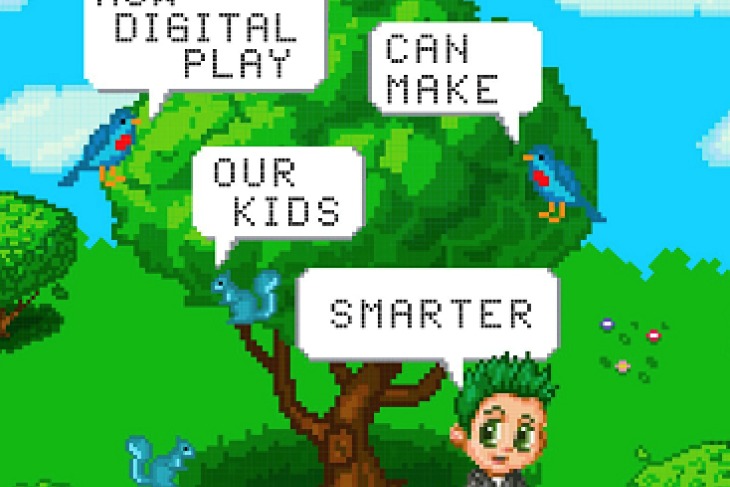Editor's note: This post originally appeared in a slightly different form at U.S. News & World Report.
I wanted to hate this book.
I’m a bit of an education technology skeptic, but I come by it honestly. No field overpromises and underdelivers more than education. And nowhere within education is that more true than among education tech’s various cheerleaders. For years, we’ve heard innovators, disruptors, and paradigm shifters natter on about twenty-first-century skills, flipped classrooms, and the “school of one.” Meanwhile, the experience of school for most kids remains the same, with the same mediocre outcomes year after year. Read my lips: No new TED Talks.
So I confess that I opened Greg Toppo’s The Game Believes in You with an arched eyebrow. I’m not ready to abandon my skepticism entirely, but Toppo made a persuasive case that games do many of the things we expect schools and teachers to do—differentiate instruction, gather data, and assess performance—and very, very well.
He started to win me over by not making the standard, clichéd education tech enthusiast’s argument about student engagement and “meeting the children where they are.” I don’t think the phrase “digital native” even appeared in the book. That was a pleasant surprise. There is something imprinted deep in the teacher’s soul that believes learning is heavy lifting, prompting us to look with suspicion, if not hostility, at games. There’s a time and place for fun in our classrooms, but it’s usually after the demanding work is done. The view changes, however, when you look at games as Toppo did, through the lens of cognitive science. As Toppo wrote:
What looks like escapist fun is actually deep concentration. What looks like instant gratification is, in fact, delayed gratification in clever disguise. What looks like spectacle is a system that is training players to ignore the spectacle and focus on the real work at hand. What looks like anything-goes freedom is submission to strict rules. What looks like a twenty-first-century, flashy, high-tech way to keep kids entertained is in fact a tool that taps into an ancient way to process, explore, and understand the world.
Toppo is the national education reporter for USA Today and a former teacher who has maintained his instructional lens. Reading his book, I began to recognize that some of my own favorite classroom lessons and routines were not effective because I’m some kind of genius kid whisperer, but because (I now realize) I unwittingly tapped into what Toppo described as the “game layer”: an overlay of game mechanics onto everyday tasks. What were the timed math drills I administered, with each student tracking correct answers and personal best times, if not a kind of multilevel game? What were the oral language editing exercises I did with my kids if not a puzzle they enjoyed solving together? What was my model classroom economy, with each student performing different jobs, if not a kind of SimCity?
Recognizing the gaming elements already present in so many classrooms softened me up. But what really pushed me to rethink my skepticism was my downright hostility to another fashionable educational idea—the myth of differentiated instruction. As any teacher will tell you, differentiation is the ultimate educational cure-all. It’s perfectly fine to have twenty-five kids in a single classroom who are all over the map in terms of their knowledge and skill levels. A single teacher can be all things to everyone, the notion goes, provided she is sufficiently skilled at “differentiated instruction.” In theory, differentiation is grand idea. In practice, it tends to complicate a teacher’s work and dumb down instruction. The excruciating difficulty of doing it effectively means that many teachers don’t do it at all.
Differentiation may be an education custom more honored in the breach than the observance. But it’s the soul of what digital games do. “A well-designed game sits and waits...and waits,” Toppo wrote. “It doesn’t care if that wearisome math problem takes you fifteen seconds or four hours. Do it again. Take all day. The game believes in you. Increasingly, it also knows you, or at least your abilities, better than anyone.”
Digital games assess students with equal aplomb. “The learning is the assessment,” observed Toppo. “One of the pleasures of these games is, quite simply, the luxury they afford us to learn, to see instantly how well we’ve learned, and then to try again without fuss or interruption until we succeed.” Indeed, a good game is a nonstop assessment. “Think about it,” said linguist and games researcher James Paul Gee. “If I make it through every level of Halo, do you really need to give me a test to see if I know everything it takes to get through every level of Halo?”
The fly in the ointment—the reason to maintain a degree of skepticism about educational gaming—is that not all games are (or will be) created equal. It’s easy to see how math, science, civics, and economics can be taught with rich curricular content embedded into the game. I’m a little less sanguine about the humanities. One of the least satisfying examples in The Game Believes in You is a simulation game based on Henry David Thoreau’s Walden. It might offer an engaging immersion experience in the writer’s world, but that is simply not the same experience as reading Walden.
"I really hope that gaming is not the next big thing in education, because the next big thing in education always sucks,” Toppo tells me. “I hope it's the next small thing, and it just keeps going under the radar.”
Just so. I’m not ready to abandon my skepticism about education technology and gaming completely. But The Game Believes in You has convinced me I need to take a new look at something I thought I’d made up my mind about long ago. I hope I’m not the only one.

